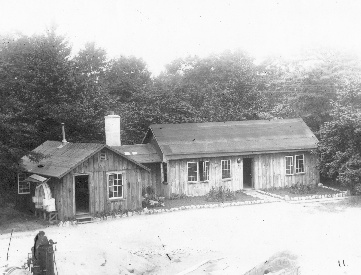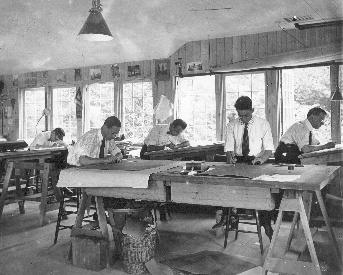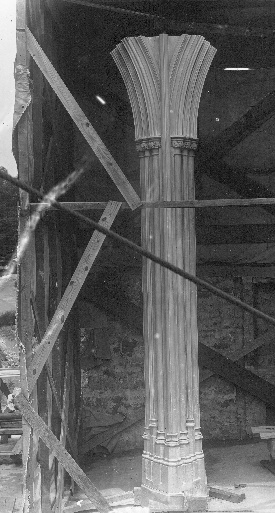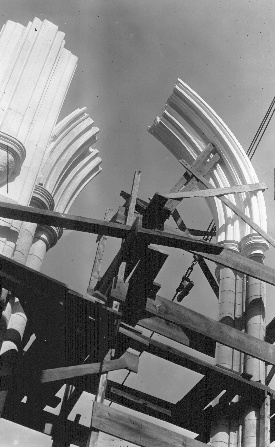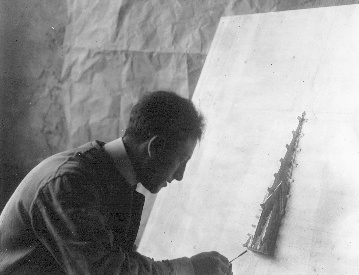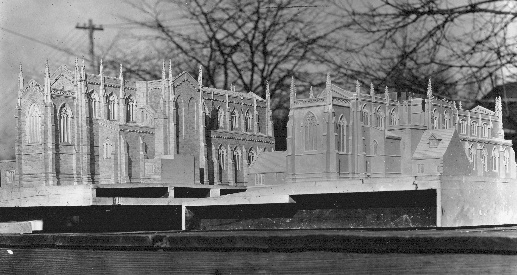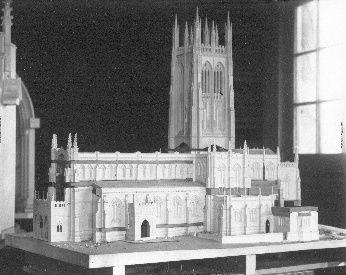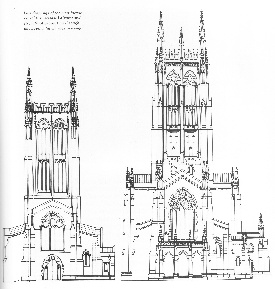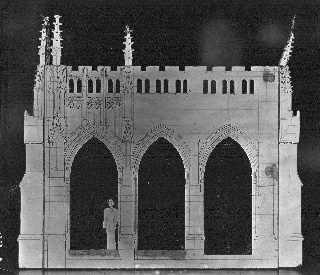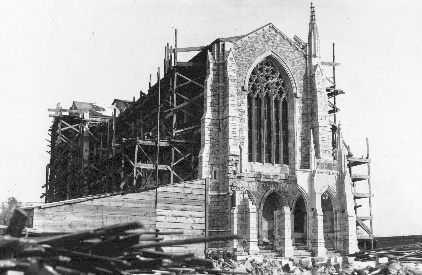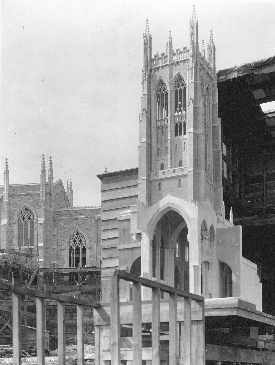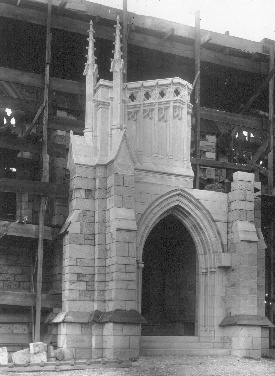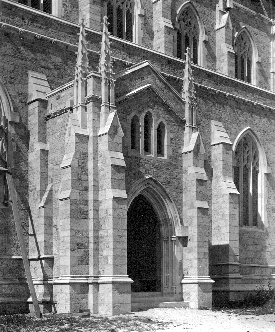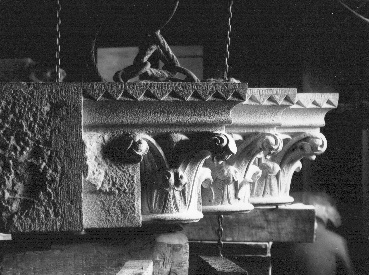Bryn Athyn Cathedral: The Building of a Church
E. Bruce Glenn
Organic Design
THE MAIN BUILDING of the Bryn Athyn Cathedral was begun in 1913. The cornerstone was laid on June 19, 1914; and the church building was dedicated to the uses of worship on October 5, 1919. The Council Hall was completed in 1926, and the Choir Hall, essentially, in 1928.
This flat listing of dates suggests a deliberateness in itself unusual today. The story of those years is one of development and experiment that had no precedent in modern building practice. Indeed, the principles of design and execution that governed the building at Bryn Athyn were a rejection of modern fixed building economy; not from anachronistic petulance, but for the sake of beauty that is inseparable from integrity, and that constituted the hallmark of the early medieval builders. It is these principles of design and execution which have excited the interest of architects and artists, and drawn visitors from all walks of life to delight in the Cathedral.
Ralph Adams Cram, the famous architect of American Gothic structures, to whose firm, Cram and Ferguson, had been given the original designing of the Bryn Athyn church in 1913, recalled five years later:
We made our first sketches, as for any ordinary piece of work, with no idea that it would prove anything out of the usual.1
That it proved something very much "out of the usual" is implied not only by Cram's statement, but also by the need to refer to his firm as being responsible for the original designing; for, like the medieval churches which lent so much inspiration to Bryn Athyn, both as to form and method, this twentieth century church is an organic structure, the result of growth and change and unceasing aspiration.
The site had been determined. Architectural drawings from a Philadelphia firm had been submitted and discussed, and final acceptance was nearing, when strong criticism led to reconsideration and final discarding of these plans. The main critic was John Pitcairn's eldest son, Raymond, a young man recently established in Philadelphia law practice. Following the rejection of the first architectural plans, he was given responsibility to take positive action toward the building of the church. On November 27, 1912, he wrote to Ralph Adams Cram in Boston, outlining the needs at Bryn Athyn and soliciting the well-known architect's personal interest. Thus began Raymond Pitcairn's association with the work which was before long to take up his entire time, and for which, within four years, he became solely responsible as architect-builder.
Years later, in response to a query, he wrote:
You inquire concerning my own architectural experience. My training was not of the professional variety. My mother was a great lover of architecture and landscape gardening, and started me in this line by cutting out pictures of churches, houses and monumental buildings, which as a child I pasted in scrapbooks.2
Trips to Europe confirmed this early bent, and gave rise to an ever increasing and refining love of medieval art and architecture. When the opportunity arose to take part in the designing and construction of the Cathedral, the young lawyer immersed himself in definitive studies of Romanesque and Gothic architecture, and gathered treasures from those great periods to serve him and his artists as examples of inspiration and workmanship. He further relates:
My lack of training in draftsmanship and the reading of architectural drawings, I endeavored early in the work to offset through dealing with the designs in the form of scale and full sized models, for the making of which, I set up a department at first in our stable and garden house.3
Requisite to all else, of course, was a love of the end in view, a sensitive interest in the beauty and strength of the materials of nature, and an appreciative understanding of their use in art and architecture. These Raymond Pitcairn had evinced years before the Cathedral was begun; his entrance into the work was no dilettante's whim, but an established conviction as to the way to build truly and worthily.
Thus, when R.A. Cram came down from Boston in the spring of 1913 to confer for the first time on his new assignment, he met with Bishop William F. Pendleton and Messrs. John and Raymond Pitcairn in a small studio which the latter had erected two years before. Of this studio, Raymond Pitcairn later wrote that it was "a humble school in those principles which we used with far greater seriousness in the building of the Church. . . .
As is usual with building operations, the work began with an architect and building contractor. . . . The studio was completed without either architect or contractor, by men employed on a time basis. The intention was for the studio to grow both in design and in manner of execution. The conclusion of a contract for a fixed sum of compensation was incompatible with a quantum and quality of work which in the very nature of the undertaking could not be fixed beforehand. The remedy adopted was to employ, and direct personally, those who did the building . . .I gathered stones for the great fireplace from the fields, from old stone walls, and from a local quarry, and employed a local mason to build it. The hearth was made of flat stones from the creek. The andirons were fashioned by the village blacksmith. . . . Trees for the timber work and roof had been secured a few miles north of Bryn Athyn, and our plans developed on the spot where the studio was being built. We also used a tri-dimensional model . . . of one of the Gothic clusters of hand-fabricated timber posts with their curved struts. . . . This model took the place of architectural drawings of a complicated feature, . . . and presented the scheme in very palpable form. Later our carpenter . . . tried the actual timbers in place to be passed on before being finally built.
We tore out original features which did not please, and introduced new ones—an additional fireplace, a new stairway and landing, and a new and enlarged south dormer window. In order to scrape off the rough saw-mill marks, and give a hand finish to the roof timbers, I provided some laborers with old-fashioned floor scrapers . . .4
Thus unknowingly did the builder serve his apprenticeship for the task that lay ahead. The studio still stands across Huntingdon Pike from the Pitcairn home. It is worth the notice we have given it, not for itself nor because it resembles in any direct sense the Bryn Athyn Cathedral, but because it prefigured remarkably the principles of design and execution that gave the Cathedral its integrity and beauty. These principles Raymond Pitcairn summed up thus:
The studio proved to have been a sort of experimental laboratory for formulating principles and methods; and they are briefly these: Growth of designs that develop with the building is inherent in the creation of living architecture. A building contract treating changes in designs as exceptions not to be encouraged, and preordaining a lump sum compensation for work which in nature and amount cannot be specified beforehand, is inimical to good building. Artistic guidance applied continuously, and designers and craftsmen who work side by side, see eye to eye, and strive ever to build better and to produce work more beautiful, are needed for real building. The use of local materials, the study and development of designs by the aid of tri-dimensional models, the trial of materials in place before their final building in, and a determination to abandon even finished work, if this will lead to something better—all contribute toward building in the Gothic way. The art of such building abhors the impress of triangle and T-square; it loves hand work, respects always the limitations of the materials and the crafts employed, regarding those limitations not as fetters but as moulds for delineating the very forms through which it should convey its message truly and with the greatest power. The soul of such an art should be the love of use, in the doing of which is found its joy and true reward.5
This ringing declaration speaks a challenge to its age. It is a statement of faith in the dignity of human work, rejecting the mechanization and specialization that have denied to so many in our century the inward content of knowing the fruits of their labor. Ruskin had proclaimed that it is slavery for one man to execute another's work, and had pointed to the Gothic as the great expression of human freedom.6 Now the ideal of the integrity of work, the wholeness of man, was to be given new expression—not as a social experiment, but in order to build soundly and well for the worship of God.
A practical necessity for such work, repeatedly voiced by Raymond Pitcairn, was that it be done at the site. In no other way could the organic quality of growth be assured. Perhaps the nature of this departure from current practice can be most clearly realized by contrasting a detail of the building as it stands—the constantly varied hinges and handles upon the doors—with an advertisement received during construction:
We . . . manufacture a full line of hardware, including beautiful designs in Gothic, Greek and Romanesque, especially suited for churches. We are sending you some printed matter describing a portion of our line. Our local agents, P. & F. Corbin of your city, will be glad to show you samples and to quote you prices . . .7
It is not for us here to debate the commercial usages of our day; suffice it to say that the Bryn Athyn Cathedral was not erected in accordance with those usages. It rose in response to a different vision, realized by methods long set aside by a world geared to mass production.
The selection of materials for the Cathedral and the organizing of groups of artisans in workshops about the edifice figured importantly in that realization. But before stone could be hauled, and mallet and chisel laid to it, the idea of its ultimate use had to be formed on paper and in plaster. Let us now see how the design as a whole, the proportioning and drafting of its parts under the principles declared by the builder, grew to be a part of the function at Bryn Athyn, until the remote offices of the original architects in Boston were left behind, and the whole endeavor went forward to its culmination under the constant guidance of Raymond Pitcairn.
The architectural studio seen from the scaffolding of the church. Its plain lines and weathered boards, its windows open to the sun and air may symbolize the sincerity—the candid absence of pretense—which characterize the design work within. Click on image for a larger version.
Here men of differing backgrounds and varied talents worked at their drawing boards with mutual purpose heightened by friendly rivalry. Click on image for a larger version.
"Growth of designs that develop with the building is inherent in the creation of living architecture."8 This first principle of good building is the sine qua non of all good art. A Beethoven symphony, a Shakespeare play, the cathedrals of the Ile de France, did not spring full-blown from the mind in perfect finality, but grew and changed as each part was seen in relation to the growing whole. And if that whole be an architectural mass of size and complexity, its organic development must needs be seen through time and controlled upon the site. So Kingsley Porter, speaking of "the Gothic way" in his book, Beyond Architecture, wrote:
No railroads made it possible for the mediaeval master-builder to journey from one part of the country to the other, so he was unable to direct the construction of more than a single building at a time. Thus he was able to put into the one piece of work which he did do, the energy the modern architect divides between many. The poverty of the mediaeval master-builder obliged him to superintend the actual construction in person, instead of leaving a corps of workers to interpret his drawings. This was his greatest gain. For a true work of art must be executed by the man who designs it. On paper or in the imagination, those essential lines upon which the artistic effect primarily depends can never be studied to as great advantage as when the artist actually sees the object created taking form beneath his hands. The very tediousness of the execution gives opportunity for more mature thought, for more careful study.9
This analysis of the greatness of medieval church design also gives perspective to the events associated with the architectural direction at Bryn Athyn between 1913 and 1917. These events were at times misinterpreted and the underlying motives misunderstood. Time has dispelled the cloud, leaving the Cathedral to speak for itself in full sunlight. Yet the story of its architectural development must be reviewed, difficulties as well as achievements; and this, not merely for the record's sake, but as requisite to a full appreciation of the building as it stands. As Porter, one of those who early saw its promise and delighted in the fulfillment, testified in Beyond Architecture:
The church at Bryn Athyn is an epoch-making masterwork of architectural art, created with joy, full of artistic conscience. . . . [It raises] our national architecture to a new level of intellectual and artistic attainment. Yet . . . the Bryn Athyn church . . . [is] far less spoken of than many quite commonplace buildings. If we had adequate criticism, the value of such works would be at once recognized, and encouragement thereby given for the production of others inspired by equally high ideals.10
If adequate criticism is lacking (the above words were written nearly half a century ago), the historical account may at least bear witness to the endeavor and display the result in clearer light.
Preliminary sketches were made by Cram and his draftsmen in Boston, in accordance with needs set forth by Bishop W.F. Pendleton. These were favorably received by him and by John and Raymond Pitcairn; and working drawings were begun. At this point, the first departure from ordinary architectural practice was set in motion—a departure that was to characterize the designing and execution of the entire church. At Raymond Pitcairn's request, a quarter-inch model was constructed in Boston from the plans drawn by Cram and Ferguson, and shipped to Bryn Athyn for study. This was the first of many plaster models, almost all of which were made in Bryn Athyn, ranging from small-scale presentation of the whole structure to full-scale models of detailed carving, of columns, arches, mouldings, pinnacles, whole porches, that were tried in place, judged in the context of their surroundings, and modified. It was on the basis of such three-dimensional models that Raymond Pitcairn felt he could see and help shape the future structure in stone; the modeling department at Bryn Athyn cannot, perhaps, be overemphasized in terms of its contribution to the development of the Cathedral. Even the trained eye cannot make the leap from the flat—and frequently flattering—drawing upon the draftsman's board to the fully realized object as it will stand.
A full-scale plaster model of a free-standing column designed for the chancel awaits close study in the varying lights and moods of the day. Later it may be placed in situ for further consideration before its counterpart is raised in stone. Click on image for a larger version.
Plaster arches have here been placed atop piers of stone. Only thus may the qualities of the design be experienced in full effect. Even with this use of models in place, actual stone work was in places torn out to make way for better composition. Click on image for a larger version.
This departure from modern practice is authorized by the custom of medieval builders (and, of course, sculptors of all the ages), builders whose use of models may have arisen from lack of paper, but whose limitations were thus turned to strengths—as, unfortunately on the other hand, frequently our modern conveniences prove to be sources of shallowness and insufficiency.
Once more it is Kingsley Porter who, in discussing this subject, gives cogent expression to a sound viewpoint:
The use of paper has . . . led to deterioration in the quality of detail. In mediaeval times the man who cut a capital was himself an artist. He designed what he executed. The discovery of paper has made it possible for the architect or his office force to design on paper all the details. The drawings are given to the workmen, who copy them mechanically. The result has been a great decline in craftsmanship. . . . Modern architecture, like everything else modern, has too often been wholesale. . . . The architect no longer senses the building growing beneath his hand . . .The disadvantages of paper architecture might . . . be overcome by the use of tri-dimensional models, employed with such effect at Bryn Athyn. Certain it is that new methods should be devised to meet new conditions, and if the new conditions have produced difficulties that have not been solved, the fault lies not so much with the conditions themselves as with us who have failed to meet them.11
One of the earliest workers in the modeling shed setting his hand to the finishing of a plaster pinnacle. He and others spent many years at this function, noted by Kingsley Porter, a leading student of medieval architecture, as essential to great architectural creation. Click on image for a larger version.
The first model arrived from Boston in June 1913. After several weeks of study, Raymond Pitcairn wrote a seven-page letter to Cram, suggesting a number of changes. Among them was the heightening of the tower as much as ten feet. He had cogent reasons for the proposal: the angle of the western slope from which it would be viewed, the ultimate size of the building mass below, and the appearance of similar towers constructed in both medieval and modern times. These points revealed a sense of perspective and proportion as well as a deep involvement with the undertaking. He went on to make further suggestions about the lines of the vestry, the buttress profiles, and the relation of the sanctuary to the whole. Yet Pitcairn could not have suspected that he was embarking on a course that would lead to giving his full time to the work of building the Cathedral, and make him fully responsible for its completion. He could not have foreseen, for example, that the tower for which he was proposing a few added feet of height would, in the next five years, undergo changes of design that were to render it an entirely different piece of work from that modeled in 1913—changes incremented through models of varying scale so that, little by little, the tower would become what was revealed when the scaffolding was removed in 1919, an expression of organic architecture.
These earliest suggestions from Bryn Athyn were received in Boston with enthusiasm, and Cram—the foremost exponent of Gothic architecture of his generation—professed to see here a return to the old relationship between architect and owner. Unlike the medieval master-builder, however, the Boston architect was engrossed in many affairs, and seldom found time to get to Bryn Athyn. Nor was he in agreement with the making of further models to set forth the effect of proposed changes in design. Nevertheless, a second model was made from the first, about which Cram wrote:
The only criticism I think that might be made is that possibly the corner pinnacles on the tower are about one foot or eighteen inches too high.12
Comparison of this model with one made later in Bryn Athyn shows strikingly how much more was to be altered and developed than the simple changing of pinnacle heights.
These two models of the church building offer dramatic evidence of the growth of design. The right-hand model was the second, developed out of the original architects' offices in Boston. The one at left, two years later (but not the last) was made in Bryn Athyn. Design changes include greater height, the adding of transepts, and arched windows in the nave clerestory. Click on image for a larger version.
The method by which these things were accomplished—it cannot be gainsaid—was the establishment of the architectural work on the site, together with the use of models for criticism and design alteration. The failure to see the need for this was one of the major factors in Cram's estrangement from the work after the start of such a promising relationship. An example of his growing indifference to a practice which he had hailed, in lecture and article, as "the old and ideal state of things"13 is seen in his letter to Pitcairn as early as December 1913:
Is there any immediate necessity of my coming in person to see you? The final working plans of the church are now finished and a set of blueprints will be sent to you today."14
How far from final were these working plans may be seen from the comparative models already noted. Nor does the later model fully represent the church as finally built; changes occurred steadily, when seen to be improvements, until the final construction. Indeed, even then finished work was torn out when a better design was proposed, or a part revised for greater harmony with the growing whole. Thus it was that, in 1919, when Pitcairn looked for elevation drawings against which to plan further buildings, he found there was not a single drawing, from any side, that represented the Cathedral as erected.
Cram's final visit to Bryn Athyn occurred in October, 1916; long before the building of the chancel and sanctuary, the tower, and many refinements and details of the finished structure in which he had no hand. Formal severance of the firm of Cram and Ferguson from the work came in the spring of 1917, in recognition of what was an established fact: that the designing of the Cathedral was being carried out not in Boston but in Bryn Athyn. Several of the draftsmen involved were still associated with Cram; but they lived in Bryn Athyn, and worked under the guidance of Raymond Pitcairn.
The number of these architectural draftsmen is in itself a testification of the organic design of the Cathedral, of its slow growth through challenge and painstaking emulation. The substance of a letter from Pitcairn to the firm in Boston, written in April, 1915, indicates this. He outlined the responsibilities of the men then working on design: Robert Tappan (who had been Cram's man on or near the site from the outset) was to exercise charge over the exterior and interior nave, aisles, porches, and tower. E. Donald Robb had charge of developing the chancel and sanctuary. Others contributing to the growing design, and to be resident in Bryn Athyn or New York, were John Walker, Harold Carswell, and Frank Parziale.
The fluid nature of the organization may be seen from the fact that final responsibility for the tower was John Walker's, while Carswell drew the completed plans for the narthex and west porch. He also was responsible for the transept gables and pinnacles.
Beyond practical advantages, working on the site brought an atmosphere of free cooperation and a sense of fulfillment too frequently denied the draftsman. This sphere was summed up in metaphor by Donald Robb in a letter of May, 1915:
The work on the church is getting a tighter grip on my enthusiasm every day, and Boston doesn't seem quite the same to me after having lived in Arcadia.15
There were, of course, the difficulties that occur inevitably in every organization of men striving side by side; but patience and the vision of their purpose sufficed to carry the work forward, in absence of that modern phenomenon of business efficiency, the managerial hierarchy which may so easily stifle creative initiative.
What were the major changes in design effected by this unique organization, that made the church by 1919 so greatly different from that proposed in 1913?
Additions to the original plan emanating from Bryn Athyn included transepts and the south porch, both of which were greatly altered in line and proportion during the subsequent years of building. Along with the adding of the transepts, three separate increases in the height of the aisle and clerestory walls made the church far more spacious and open, with greater dignity and aspiration in both exterior and interior lines. This heightening of the church, with which Pitcairn experimented by inserting strips of wood in the models, was accepted by the original architects only after strong protest; again, the comparison of models side by side, as well as the quality of the building as it stands, vindicates the judgment of the amateur striving for the expression of a religious ideal. To understand the extent of this change, it need only be noted that fifty-five percent was added to the clerestory height alone, more than half again the height of Cram's original plan.
This model of the church shows how Raymond Pitcairn tested his own proposal that the aisle and the clerestory walls be heightened. The dark lines are strips of wood inserted into the plaster model. Click on image for a larger version.
The development of the windows in the nave clerestory wall also indicates the persistent effort of the design function at Bryn Athyn. Originally designed with no arch at all, but merely a curved lintel (what Pitcairn called a "ferry-boat window"), the windows were changed to twin lancets within each bay of the nave. This too was rejected, and finally Robert Tappan hit upon what appears to the viewer now to be the obvious design—the Gothic arch which continues the pattern of the chancel clerestory and stands in harmony with the grisaille windows in the aisle wall below.
As a tree grows upward, its trunk broadens and its branches spread. The organic law of balanced growth applies also to human works; alteration of one proportion brings tremors of need throughout the whole. Thus at Bryn Athyn. Buttresses were deepened, especially those at the corners, to lend strength to the height; the profiles of pinnacles were strengthened in adjustment to vertical planes. At the east end, a parapeted, flat-roofed sanctuary design was changed to the gabled sanctuary so much more in harmony with the lines of nave and chancel that lead to it. Indeed, the entire chancel and sanctuary were redrawn in Bryn Athyn.
Line drawings of the west facade reveal the increased dignity and strength of proportion through developmental changes in design. Click on image for a larger version.
Perhaps the most challenging aspect of redesigning concerned the west portal, important as the main entrance and as the facade seen directly from across the valley. Raymond Pitcairn was dissatisfied with the proposed single-arch door, over which the great west window appeared to teeter. Discussion of the problem led to a suggestion from an artist in an entirely different field, which was eventually developed into the present three-arched porch. The artist was Winfred Hyatt, a member of the Bryn Athyn congregation and a recent graduate of the Pennsylvania Academy of Fine Arts, who had joined the Cathedral group as a designer of stained glass windows. It is a striking example of the interchange of ideas and the communal spirit at Bryn Athyn that a stained glass artist should feel free to offer an architectural suggestion, and that he could see and know enough of the design as a whole to offer a fruitful one. The instance is a tribute to the organization, a vindication of the building principles employed, and an example of the use of models. For it was to the model of the church that Hyatt attached a simple cardboard sketch of his idea for a porch—an action that could not have occurred in a building process controlled by "paper architecture" from an office three hundred miles distant! The architects in Boston opposed the porch as disproportionate to the church as a whole; but the added height and the development of the sanctuary to the east made the west porch a natural and lovely addition to the profile of the growing Cathedral. It offers shelter and the sphere of quiet to the entering worshipper, and frames a glorious view across the western valley as he leaves; it removes the flatness of the facade, its parapet, accented by pinnacles, forming a base for the window above; and in itself it is a gem of proportion and detail.
A remarkable instance of communal effort, this idea for the west porch, sketched and cut out in cardboard, came from the cathedral's chief designer of stained glass, Winfred Hyatt, in response to a need expressed by Pitcairn and unfilled for months of searching. Click on image for a larger version.
The west porch, partially erected in stone, undergoes "trial by model." The right-hand arch, balustrade, and pinnacles are of plaster. Click on image for a larger version.
Finally, among the changes in design wrought into the Cathedral by architects and draftsmen with their eye upon the object, the tower which stands above declares the truth of the principle that "growth of designs that develop with the building is inherent in the creation of living architecture."16 It is not just a question of added height or of subtle refinements. The entire complex of lines—windows, balconies, buttresses, parapets, and pinnacles—was redrawn and again redrawn, first by Robert Tappan, then by John Walker; and this despite general admiration of the tower as first designed in 1913. In December of that year, Pitcairn had written to R.A. Cram, "The Tower looks superb on the plans and I can scarcely wait for the model."17 More than two years later, he concluded a letter to Tappan, "I believe that when the Bryn Athyn tower is finished it will certainly be the most beautiful tower in America, and in looking through the books I do not find any that appeals to me more."18
Nevertheless, the search for still greater beauty was to continue. One of the most revealing models made at Bryn Athyn was a large-scale representation of the tower in plaster. So carefully done that it looks at a glance like the finished work in stone, it reveals its purpose by close comparison of the facades. For such comparison the model was placed on rails, so that it could be wheeled out into the open air to study the effects of sunlight upon its contours. On this model were tried alternate plans for the height of the great lancets, the use of balconies at the base, types of cornice and tracery, and other detail which might seem insignificant to the observer on the ground below, but which, taken together, have realized the promise expressed in the words quoted above.
A model of the tower, so finished in appearance that in photographs that isolate it from its surroundings it might be mistaken for the finished tower . . . until one notices the variations in windows and other design features placed side by side for comparison. Behind are the chancel and sanctuary, with windows yet unglazed. Click on image for a larger version.
So the Cathedral grew in design, at times barely ahead of the structure itself—line by line, plane upon plane. Such a process, unless strongly guided by principles of taste and by sound precedent, might easily degenerate into an orgy of adornment, a game played for its own sake. The pitfall was avoided at Bryn Athyn, partly by the natural checks and balances of the architectural organization, but also largely because of Raymond Pitcairn's conviction that the earlier simplicity of the Romanesque-Gothic transition was better than the more ornate architecture of the perpendicular period. Historically, the structural cleanness of the twelfth and thirteenth centuries had given way to the adornment, the striving for effect of the later Gothic. In reverse of this trend, the development of the church at Bryn Athyn was one of return to the stronger, more fundamental lines of the earlier centuries, after an initial plan that reflected the later period. The overwrought filigree of tracery, the attenuated slenderness of buttress and pinnacle, the decorative emphasis of detail in parapet—these gave way successively, in drawing and model at the Bryn Athyn shops, to designs in which the parts were integral, the details fashioned to serve the mass and lighten it.
Especially was the use of non-structural stonework avoided, the flying buttress that filled no need as support, the arch or vault that did not bear its burden truly, the wall that was only a false facade. Anything suggesting sham was not tolerated; witness this portion of a letter from Pitcairn to Cram in May, 1914:
Another point is with regard to the flying buttress effect obtained by the aisle half-arch, which springs from the aisle wall into the great pillars. . . . Somehow this is distressing to me, and I feel most people agree with me in this matter. . . . I feel that the arched spring should build up out of the wall and should strike the . . . pillar in a very simple, structural manner, without elaborate molding. . . . It should look so entirely structural, that its reason for existence and its manner of treatment, would be perfectly obvious.19
That this view prevailed may be seen in the simple half-arches that strengthen the lines of the nave aisles without distracting by superfluous ornamentation. They are there to support the pillars which bear the clerestory, and they do so with noble dignity.
Again is seen the combined placing of finished stonework and plaster model. This is the tentative south porch, with the ornate paneling and tracery of the later gothic. Click on image for a larger version.
The south porch as finished; a lovely portal, with the grace and dignity lacking in the decorative effort of the earlier model. Click on image for a larger version.
This comparative simplicity of line and detail is not a bareness bereft of human expression. Designed for worship, not as a showpiece, the Cathedral shows forth its high purpose in a warmth reflecting love and felt even by the casual visitor.
In addition to organic planning and the dedicated workmanship of many hands, there is in the Bryn Athyn Cathedral another design element of importance. It is an element woven with care and discernment throughout the work, in the line of wall and cornice, the shaping of arch, the spanning of roof, the rising of the tower. This is the use of refinements—curves and bends in horizontal plan and elevation, asymmetric departures from the inert exactitude of a machine age, that delight the eye in giving life to the structure before it. These refinements, unique in modern building, merit a separate chapter.
A thing of beauty even when hanging in isolation, this rhythmic capital—a single block of Plymouth granite—now graces the arch at the base of the Ezekiel Tower. Click on image for a larger version.
Top | Previous Chapter: A Church of the New Christianity | Next Chapter: Architectural Refinements and Variations | Table of Contents
Footnotes top
1 Ralph Adams Cram, "A Note on Bryn Athyn Church," The American Architect 113, no. 2214 (May 29, 1918): 710.
2 Raymond Pitcairn. Letter to John T. Comes. 10 May 1920. Glencairn Museum Archives, Bryn Athyn, PA.
3 Ibid.
4 Raymond Pitcairn, "Bryn Athyn Church: The Manner of the Building and a Defence Thereof" (book draft, Glencairn Museum Archives), 14–15 (draft two).
5 Ibid., 16.
6 See John Ruskin, "The Nature of Gothic," in Stones of Venice, vol. 2 (New York: J. Wiley, 1883), 159 ff.
7 C.B. Parsons. Advertising letter to Raymond Pitcairn. 13 March 1914. Glencairn Museum Archives, Bryn Athyn, PA.
8 Raymond Pitcairn, "Bryn Athyn Church: The Manner of the Building and a Defence Thereof" (book draft, Glencairn Museum Archives), 16 (draft two).
9 A. Kingsley Porter, Beyond Architecture (Boston: Marshall Jones Company, 1918), 70. Emphasis added.
10 Ibid., 190.
11 Ibid., 156–157, 159, 162–163.
12 Ralph Adams Cram. Letter to Raymond Pitcairn. 17 February 1914. Glencairn Museum Archives, Bryn Athyn, PA.
13 Ralph Adams Cram, The Ministry of Art (Boston and New York: Houghton Mifflin Company, 1914), 162.
14 Ralph Adams Cram. Letter to Raymond Pitcairn. 3 December 1913. Glencairn Museum Archives, Bryn Athyn, PA.
15 E. Donald Robb. Letter to Raymond Pitcairn. 11 May 1915. Glencairn Museum Archives, Bryn Athyn, PA.
16 Raymond Pitcairn, "Bryn Athyn Church: The Manner of the Building and a Defence Thereof" (book draft, Glencairn Museum Archives), 16 (draft two).
17 Raymond Pitcairn. Letter to Ralph Adams Cram. 5 December 1913. Glencairn Museum Archives, Bryn Athyn, PA.
18 Raymond Pitcairn. Letter to Robert Tappan. 10 February 1916. Glencairn Museum Archives, Bryn Athyn, PA.
19 Raymond Pitcairn. Letter to Ralph Adams Cram. 1 May 1914. Glencairn Museum Archives, Bryn Athyn, PA.
